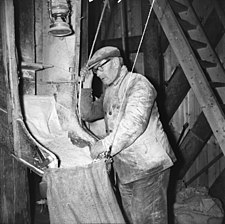Miller: Difference between revisions
Appearance
Content deleted Content added
m Undid revision 711135867 by 66.131.88.15 (talk) |
|||
| Line 17: | Line 17: | ||
==Description== |
==Description== |
||
FANCY BOII |
|||
[[Mill (grinding)|Milling]] is among the oldest of human occupations. "Miller", "Milne" and other variants are common surnames,<ref>{{Google books|k8hrAAAAMAAJ|Surname Book and Racial History: A Compilation and Arrangement of ...|page=165}}</ref>{{rp|165}} as are their equivalents in other languages around the world ("[[Müller (surname)|Müller]]" or "[[German surname|Mueller]]" in [[German language|German]], "[[Molnár]]" in [[Hungarian language|Hungarian]], "Molinero" in [[Spanish language|Spanish]], "[[Molinaro]] or [[Molinari]]" in [[Italian language|Italian]] etc.). Milling existed in [[hunter-gatherer]] communities, and later millers were important to the [[history of agriculture|development of agriculture]]. |
|||
The materials ground by millers are often [[foodstuff]]s and particularly [[cereal|grain]]. The physical grinding of the food allows for the easier digestion of its [[nutrient]]s and saves wear on the teeth. Non-food substances needed in a fine, powdered form, such as [[building materials]], may be processed by a miller. |
|||
[[Image:Bedandrind.jpg|A Bedstone & the Rind.|Px150|left|thumb|A bedstone and rind. [[Dalgarven Mill]], Scotland.]] |
|||
The most basic tool for a miller was the [[quern-stone]]—simply a large, fixed stone as a base and another movable stone operated by hand, similar to a [[mortar and pestle]]. As technology and [[millstones]] (the [[bedstone]] and [[Millrind|rynd]]) improved, more elaborate machines such as [[watermill]]s and [[windmill]]s were developed to do the grinding work. These mills harnessed available energy sources including animal, water, wind, and electrical power. Mills are some of [[mill (factory)|the oldest factories]] in human history, so factories making other items are sometimes known as mills, for example, [[cotton mill]]s and [[steel mill]]s. These factory workers are also called millers. |
|||
The rynd in [[history of Scotland|pre-reformation Scotland]] was often carved on millers' gravestones as a symbol of their trade. |
|||
In a traditional [[rural]] society, a miller is often wealthier than ordinary peasants, which can lead to jealousy and to millers being targeted in [[bread riots]] at times of [[famine]]. Conversely, millers might be in a stronger position vis-a-vis [[feudal]] land owners than are ordinary peasants. |
|||
[[Image:Monselice z21.JPG|thumb|right|A man dressed as a [[Middle Ages|medieval]] miller at a festival in [[Monselice]].]] |
|||
The traditional carnival held annually in the city of [[Ivrea#Culture|Ivrea]], [[Italy]] commemorates a spirited "Mugnaia" (miller's daughter) who supposedly refused to let a local duke exercise his [[right of the first night]], and proceeded to chop the duke's head off and spark a revolution. Whatever the historical validity of the story, it is significant it was the daughter of a miller to whom folk tradition assigned this rebellious role. |
|||
==See also== |
==See also== |
||
Revision as of 19:00, 20 September 2016
This article needs additional citations for verification. (June 2013) |
 Miller at work in the De Hoed, Waarde windmill, Netherlands. | |
| Occupation | |
|---|---|
Occupation type | vocation |
Activity sectors | Agriculture |
| Description | |
| Competencies | Buying & Selling, Math, Machine repair, |
A miller usually refers to a person who operates a mill, a machine to grind a cereal crop to make flour.
Description
FANCY BOII
See also
- Gristmill, a name for grain mills
- Medieval watermills, a list of early medieval watermills
